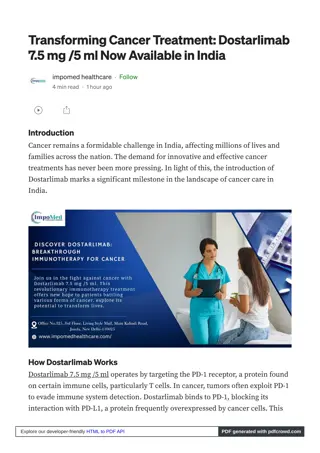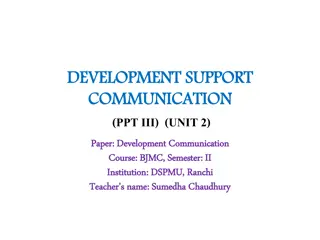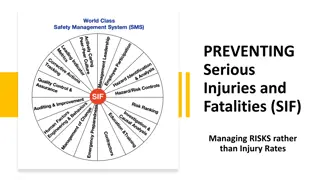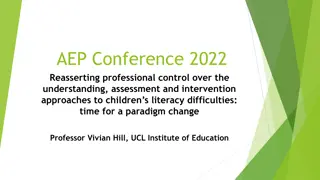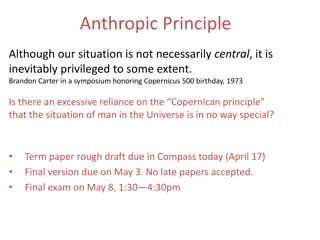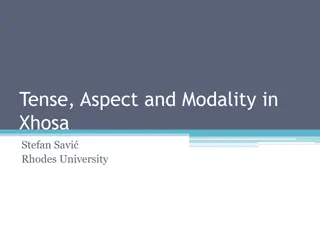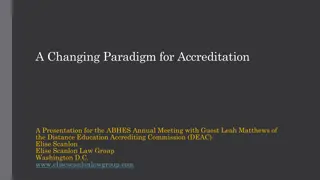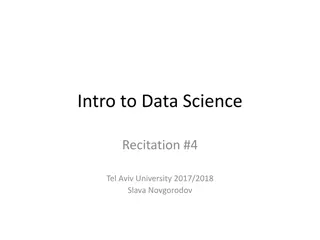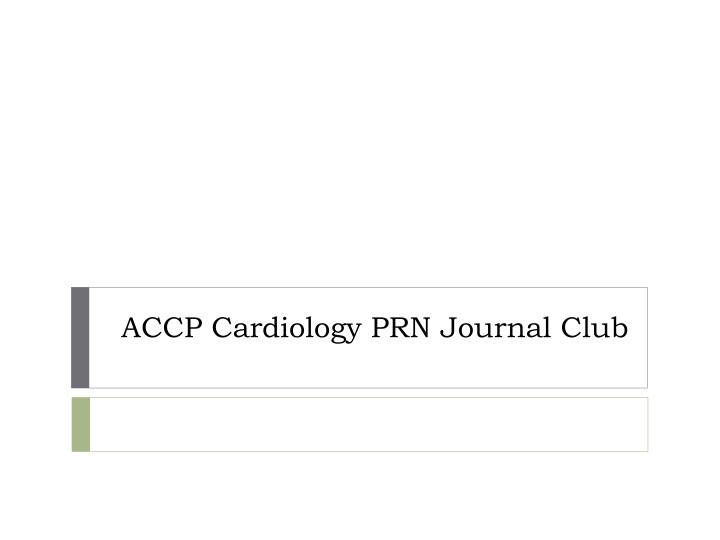
Angiotensin-Neprilysin Inhibition in Heart Failure: Insights from PARADIGM-HF Trial
Explore the efficacy of angiotensin-neprilysin inhibition versus enalapril in heart failure as discussed in the PARADIGM-HF trial. Understand the background, purpose, and outcomes of this study to enhance your knowledge in cardiology. Join the ACCP Cardiology PRN Journal Club for in-depth discussions and stay updated with the latest advancements in the field.
Download Presentation

Please find below an Image/Link to download the presentation.
The content on the website is provided AS IS for your information and personal use only. It may not be sold, licensed, or shared on other websites without obtaining consent from the author. If you encounter any issues during the download, it is possible that the publisher has removed the file from their server.
You are allowed to download the files provided on this website for personal or commercial use, subject to the condition that they are used lawfully. All files are the property of their respective owners.
The content on the website is provided AS IS for your information and personal use only. It may not be sold, licensed, or shared on other websites without obtaining consent from the author.
E N D
Presentation Transcript
Announcements Thank you attending the ACCP Cardiology PRN Journal Club Thank you if you attended last time I have created a PB Works Site that will house our recorded calls, handouts, and Summary/Q&A documents. I will be e- mailing the link to this in the next 1-2 weeks. Still trying to explore option of getting CE. If there are any suggestions, please let us know.
Angiotensin-Neprilysin Inhibition versus Enalapril in Heart Failure (PARADIGM-HF) Prepared By: Robert K. Tunney, PharmD, BCPS PGY2 Cardiology Resident, Vanderbilt University Medical Center, Nashville, TN McMurray JV, et al. N Eng J Med. 2014; 371: 993-1004.
Disclosures I have no financial interest or affiliation with the manufacturer of any marketed product discussed herein
Background Heart Failure (HF) Constellation of symptoms 5.1 million Americans (and rising) with HF ~20% lifetime risk for the development of HF in patients > 40 years old Lack of consistency in mortality benefit with angiotensin- receptor blockers (ARBs) CHARM (2004) and Val-HeFT (2001) 2013 ACC/AHA Guidelines: ARBs recommended in patients intolerant to ACE-I therapy (IA) McMurray JV, et al. N Eng J Med. 2014; 371: 993-1004. Yancy CW, et al. JACC. 2013; 62(16): e147-e239.
Background: Neprilysin Inhibition (NI) LCZ696 Natriuretic peptide system Renin-angiotensin system Natriuretic Peptides Angiotensinogen (liver) AHU377 (sacubitril) Inactive Metabolite Angiotensin I Inactive Fragments Angiotensin II Valsartan 1.) Vasodilation 2.) Natriuresis/diuresis 1.) Vasoconstriction Adapted from Bonow RO, et al. Global Cardiology Science and Practice. 2014; 34: dx.doi.org/10.5339/gcsp.2014.34. Fig. 1.
Background and Purpose OCTAVE trial (2004): Neprilysin (omapatrilat) and ACE-I combination intolerance secondary to angioedema LCZ696: sacubitril + valsartan (fixed molecular complex) Purpose Assess the relative superiority of morbidity and mortality benefits between LCZ696 200 mg BID and ACE inhibition (enalapril 10 mg BID) in patients with HFrEF McMurray JV, et al. N Eng J Med. 2014; 371: 993-1004.
Study Design Randomized, double-blind, parallel group, active-control trial of 8,442 patients in 47 different countries Double-blind, randomized treatment period: 22 months (Visit 5) Single-blind run-in Period 5-10 weeks (Visits 2-4) Screening Period (Visit 1) McMurray JV, et al. N Eng J Med. 2014; 371: 993-1004.
Study Design: Run-In Period McMurray JV, et al. N Eng J Med. 2014; 371: 993-1004.
Study Demographics Characteristic Region North America NYHA Functional Class I II III IV Medical History Implantable cardioverter- defibrillator Cardiac resynchronization therapy (CRT) LCZ696 (n = 4187) Enalapril (n = 4212) 310 (7.4%) 292 (6.9%) 180 (4.3%) 2998 (71.6%) 969 (23.1%) 33 (0.8%) 209 (5.0%) 2921 (69.3%) 1049 (24.9%) 27 (0.6%) 623 (14.9%) 620 (14.7%) 292 (7.0%) 282 (6.7%) McMurray JV, et al. N Eng J Med. 2014; 371: 993-1004.
Methods Inclusion Criteria Exclusion Criteria CHF (NYHA Class II-IV) Hypotension (SBP < 100 mmHg at screening or < 95 mmHg at randomization) Male or female aged >18 yrs Known history of angioedema LVEF < 40% (within the past six months prior to randomization) changed to < 35% in 12/10 Patients in acute decompensated HF BNP > 150 pg/mL or NT-proBNP > 600 pg/mL at visit 1 Estimated eGFR < 30 mL/min/1.73 m2 (MDRD) Stable dose of an ACE-I or ARB for 4 weeks prior to visit 1 Serum potassium > 5.2 mmol/L (visit 1) or > 5.4 mmol/L at visit 3 or 5 Stable dose of beta-blocker for 4 weeks prior to visit 1 (unless contraindicated) CVA, ACS, ventricular arrhythmia, or cardiac resynchronization device within the previous 3 months McMurray JV, et al. N Eng J Med. 2014; 371: 993-1004.
Outcomes Primary: Time to first occurrence of composite endpoint: CV death or HF hospitalization Secondary: Improvement in the Kansas City Cardiomyopathy Questionaire (KCCQ) at 8 months All-cause mortality Decline in renal function New-onset atrial fibrillation McMurray JV, et al. N Eng J Med. 2014; 371: 993-1004.
Statistics Primary efficacy variable Cox proportional hazards model (alpha = 0.05, two tail) Kaplan-Meier curves to summarize primary composite endpoint Sample Size 7,980 patients 34 months 1,229 CV-related deaths Assumed 7% annual CV death rate Est rate of primary end point = 14.5% (CHARM-Added Trial) 80% power to detect a relative reduction of 15% in CV-related deaths within the treatment group Three planned interim efficacy analyses (33%, 50%, and 67% event accrual) McMurray JV, et al. N Eng J Med. 2014; 371: 993-1004.
Results Study Outcome LCZ696 (n = 4187) Primary composite endpoint (%) 558 (13.3) 693 (16.5) Enalapril (n = 4212) Hazard Ratio (HR) P-Value 1.) Death from CV causes 2.) 1st hosp. for worsening HF 0.80 (0.71-0.89) <0.001 537 (12.8) 658 (15.6) 0.79 (0.71-0.89) <0.001 Secondary Outcomes (%) 711 (17.0) 1.) Death from any cause 2.) KCCQ Score change (8 months) 3.) Decline in renal function 4.) New Afib 835 (19.8) 0.84 (0.76-0.93) <0.001 -2.99 +0.36 -4.63 +0.36 1.64 (0.63-2.65) 0.001 94 (2.2) 108 (2.6) 0.86 (0.65-1.13) 0.28 84 (3.1) 83 (3.1) 0.97 (0.72-1.31) 0.83 McMurray JV, et al. N Eng J Med. 2014; 371: 993-1004.
Results Adverse Events LCZ696 (n = 4187) Enalapril (n = 4212) P-Value Hypotension 1.) Symptomatic 588 (14%) 112 (2.7%) 388 (9.2) 59 (1.4%) < 0.001 < 0.001 2.) Symptomatic (SBP < 90 mmHg) Elevated SCr 1.) > 2.5 mg/dL 139 (3.3%) 63 (1.5%) 474 (11.3%) 188 (4.5%) 83 (2.0%) 601 (14.3%) 0.007 0.10 < 0.001 2.) > 3.0 mg/dL Cough Angioedema 1.) No 10 (0.2%) 5 (0.1%) 0.19 treatment/antihistamine only 2.) Hospitalization (no airway compromise) 3 (0.1%) 1 (<0.1%) 0.31 McMurray JV, et al. N Eng J Med. 2014; 371: 993-1004.
Results McMurray JV, et al. N Eng J Med. 2014; 371: 993-1004.
Discussion Inhibition of both angiotensin II receptors and neprilysin was more effective in reducing morbidity and mortality relative to the control therapy Mean enalapril dose utilized = 18.9 mg daily CONSENSUS (1987): 18.4 mg 20 mg BID target dose SOLVD (1991): 16.6 mg 10 mg BID target dose LCZ696 resulted in greater incidence of hypotension but was not associated with significant increases in serious angioedema McMurray JV, et al. N Eng J Med. 2014; 371: 993-1004.
Authors Conclusion Angiotensin-receptor-neprilysin inhibition with LCZ696 proves superior to ACE inhibition alone in reducing the risk of death and re-hospitalization due to HF McMurray JV, et al. N Eng J Med. 2014; 371: 993-1004.
Critique Strengths Weaknesses Thought-Provoking Were the sickest patients studied? Reproducibility to U.S. patients Under-representation of ICD/CRT patients and those of African descent Reduction in atrial fibrillation Comparative efficacy of valsartan 320 mg versus enalapril 20 mg Study Design Robust statistical power High statistical significance Previous use of ACE/ARB Potential degree of clinical significance Drug run-in period Cost-prohibitive therapy McMurray JV, et al. N Eng J Med. 2014; 371: 993-1004. Yancy, Clyde W. "Commentary on PARADIGM HF Study Design." ESC 2014 Science News (31 Aug. 2014).
Impact on Clinical Practice Potential exists for a profound impact on HF pharmacotherapy Considerations for utilization in specific patients: Patients with past history of angioedema are excluded Lack of reproducible safety data in patients of African descent (OCTAVE) Insurance status Previous use and tolerance of an ACE-I/ARB McMurray JV, et al. N Eng J Med. 2014; 371: 993-1004. Kostis JB, et al. Am J Hypertens. 2004; 17: 103-111.
Acknowledgements Journal Club Mentors 1.) Elizabeth McNeely, PharmD, BCPS TriStar Centennial Medical Center, Nashville, TN 2.) Herb Patterson, PharmD, FCCP UNC Eshelman School of Pharmacy, Chapel Hill, NC Program Director Daniel Johnson, PharmD, BCPS(AQ-Cardiology) Vanderbilt University Medical Center, Nashville, TN ACC PRN Journal Club Coordinator Craig Beavers; PharmD, BCPS (AQ-Cardiology) TriStar Centennial Medical Center, Nashville, TN
Angiotensin-Neprilysin Inhibition versus Enalapril in Heart Failure (PARADIGM-HF) Prepared By: Robert K. Tunney, PharmD, BCPS PGY2 Cardiology Resident, Vanderbilt University Medical Center, Nashville, TN McMurray JV, et al. N Eng J Med. 2014; 371: 993-1004.
Thank you for attending! If you would like to have your resident present, would like to be a mentor, or have questions or comments please e- mail the journal club at accpcardsprnjournalclub@gmail.com or craig.beaverspharmd@gmail.com Our next Journal Club will be in early January with the date to be determined. Nicole Gasbarro from University of Chicago-Illinois will be presenting DAPT trial.


![[PDF⚡READ❤ONLINE] Black Hole Astrophysics: The Engine Paradigm (Springer Praxis](/thumb/21503/pdf-read-online-black-hole-astrophysics-the-engine-paradigm-springer-praxis.jpg)
